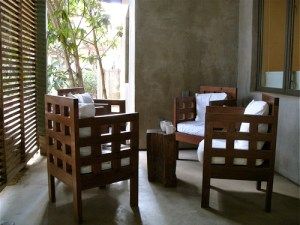
Back in my formative, single days, I read an influential article by Paul Soupiset in Communiqué. He received a clever gift from his wife – a weekend getaway/personal retreat in room #26 of Austin’s Hotel San José – and he deemed the urban bungalow lodging “a perfect spot for meditation, prayer, and contemplation.” I was newly enamored with Kathleen Norris’s book, The Cloister Walk, and so his description caught my eye. At the time, I imagined my tiny studio apartment to be my own monastic cell, and I mimicked Norris’s observance of the hourly offices as best I could while sitting on my blue futon. I went from Baptist to Anglican for the sake of poetic liturgy. Reading both pieces birthed my love for quiet, clean-lined spaces, with ample room to think and pray.
Through Soupiset’s words and photographs, I was whisked away to what Hank Williams III described as “Mexico meets Japan”: cacti and bamboo stalks outside, cowhide rugs and rice paper lanterns indoors, minimalist yet comfortable, with strong lines and simplicity. It sounded peaceful and funky enough to suit my eclectic tastes perfectly. And yet, all monastic notions aside, I wasn’t too keen on sleeping over alone, nor did I have appropriate budget, so I tucked the idea away for my marital future. When I finally said “I do” to a drummer, we spent our honeymoon in Gruene, TX, and returned the following year for our anniversary. The bustling city of Austin is nearby, so we saved our pennies, booked a room at the San José and tacked on a night to our annual getaway, thereby establishing a tradition. Since we entertained life in a convent and monastery (respectively) during singlehood, marriage seemed a celebratory occasion on which to splurge.
Reading a great article is one thing, but experiencing Hotel San José in the flesh is a very incarnational experience – it touches on all five senses, while heartening the spirit. We’ve stayed there four times, and it’s like a deep, meditative breath each time we’re handed a key. We step from the parking lot through a wide, wooden-slatted door to modern oasis landscaping courtesy of Austin’s Big Red Sun. There’s a Zen garden quality as gravel crunches underfoot; large wooden eggs are placed here and there. Lush greenery hangs from wooden trellises overhead. Birds flit from clay birdhouses hidden in tree branches. Stairs are framed with twigs and vibrant porcelain colors. Terra cotta planters nourish desert plants and succulents. You can read and sip tea on vintage patio furniture or an assortment of geometrical wooden chairs placed throughout the sculpted gardens. The hushed calm is something of a sonic miracle seeing as cars whiz by on S. Congress just steps away.

The buildings are quite satisfying to those of us who appreciate the honesty of modernism. Lake|Flato architects, believing that such a style “should respond to its particular place, enhance a site or neighborhood, and be a natural partner with the environment,” transformed an old tourist court into a sanctuary of vernacular architecture. This bungalow-style hotel is framed by stucco and gray brick walls; Spanish tiled roofs and large, olive green doors imprinted with white room numbers. Inside is a fresh take on monastic living – well, except for a flat screen TV and the mini bar (a wooden box cradling items such as Shoyeido incense, dark chocolate, and a bottle of cabernet). The white rooms display the most beautiful austerity illumined by bright, natural light, heeding another of Lake|Flato’s philosophies to explore “how the light of a specific region enlivens a space, brushes a wall, and animates materials.”
We slip off our shoes to feel cool, concrete floors and simple wool rugs woven with Rothko-esque blocks of color. The minimalist aesthetic is offset by vintage music posters on the wall, and platform beds and couches covered with tapestry pillows and hippie blankets. We slide open a massive, industrial sliding door into a sparse, white bathroom scented with the San José blend of pepperminty soap. Other furniture consists of Bertoia chairs and Saarinen tulip tables straight out of Dwell magazine. If I didn’t have an aversion to theft, I might have smuggled the red Eames rocking chair into our car when the staff wasn’t looking.
You’d never believe what this chic place used to be if I told you. I couldn’t visualize it myself, either, until I watched the documentary, The Last Days of the San José (2000), co-produced and directed by Saint Liz Lambert (as I like to call her). She purchased what was then a very ramshackle, squalid San José Motel with a vision of what it ought to be. But she acted as owner and manager for three years while she courted banks all over Texas to finance the renovations. In the meantime, she chronicled the lives of some of the tenants – a diverse lot. There were prostitutes, drug addicts, transvestites, runaway teenagers, and a self-instituted handyman attending anger management classes. There were more winsome characters, too, such as street musician Gerry Van King (the “King of 6th Street”), and Diana and her son, just trying to get by until they could afford rentable housing. One young female tenant described her surroundings as “a mini rundown Melrose Place.” And so it was.
Yet one glorious day, when Lambert finally sweet-talked a bank into a loan, it was time for all of her tenants – the good and the bad – to pack up and find other living arrangements. My heart shattered at that moment in the film. I had some less favorite characters, but I wondered, what happened in their childhood and their young adult life? Were they ever shown kindness?

There’s a scene in which the hymn “Softly and Tenderly” (sung by Robert Sean Leonard in Chelsea Walls) plays softly while scenes of the city flash slowly –
Come home, come home,
Ye who are weary, come home,
Honestly, tenderly, Jesus is calling,
calling all sinners, come home.
In that subtle, poignant moment, I got the impression that Lambert cared a great deal – she befriended many of her patrons – but a place of filth and crime is no kind of shelter. Even if their lives resembled a dark tale penned by Flannery O’Connor, Lambert extended mercy by closing down the disreputable motel. It was not a home, and needed to recapture the positive atmosphere of its beginning as an “ultramodern motor court” in 1939. If we book a swank room at the Hotel San José here in 2009, we should not forget the people who struggled in its seedier rooms, nor the story behind the bungalows. These pieces of old architecture have quite the redemptive story to tell. With the eye of an artist, Lambert looked past syringes in sinks, crack pipes tucked away in random crevices, tattered curtains, soiled bed linens, and a sickly lime green exterior. She tore it all down to create a thing of beauty, a transformation akin to the resurrection – a motel’s dying breath raised to new life.
Through her work, Lambert also restored this particular neighborhood to safety and boosted the local economy, a salvific act to any location. Today, some of the best shopping in all of Austin resides on S. Congress: the fair trade of Ten Thousand Villages, local wares at Parts & Labour, the folk art of Yard Dog, the eclectic antiques of Uncommon Objects, worldwide crafts at Tesoros – and the literary Mecca of BookPeople is just minutes away. There’s good food and drink to be found at Guero’s, Home Slice, Hey Cupcake, Woodland, and Farm to Market. There’s even great music to tap your feet by right across the street at The Continental Club, which has seen Hotel San José through the worst of times, back in its days of squalor. All of this variety is very representative of a very grateful, zany, welcoming city.
In the same spirit, Hotel San José has mastered the art of hospitality in an inspiring, creative fashion – which is why it’s called “a hotel with a soul.” They offer a rare selection of perks for rent: Americana CDs, obscure films on DVD, bicycles for gasoline-free transportation, typewriters to peck out your memoirs (though there’s also free wireless internet), and Polaroid cameras to capture the tranquility on film. Your dog is even welcome. The rooms are no longer $30-40 per night, but if you have a worthy splurge (such as an anniversary) and you’re into the Tex-Mex-Orient vibe, the quality of stay speaks for the price, in my opinion.
With her creativity, Lambert redeemed the kitsch of the utilitarian motor court aesthetic with something more personal and less dehumanizing. In addition to Hotel San José’s funky, minimalist decor, the rooms are stocked intentionally with an eye for detail. For cleansing, the toiletries are small bottles of Dr. Bronner’s peppermint soap and other exclusives created by a local Austin spa. A stack of single tissues are stacked neatly on a window sill. In each bathroom, a poem is nailed near the mirror to read while brushing your teeth. The small wine bar is the place to be, yet not raucous.

But perhaps the prime example of their artful hospitality is the room service – breakfast in a bento box. This, too, is worth every penny we save each year – maybe the most beautiful presentation of a meal I’ve ever put in my mouth, compartmentalized and all. My favorite menu consists of big bowls of plain yogurt, granola, and berries along with grapefruit juice and a Bodum urn full of Jo’s coffee (an outdoor shop next door). To top it all off, we plug in my husband’s iPod to the complimentary bedside iHome and enjoy Aradhna while waking up.
I’m never quite ready to check out at noon, so my husband and I might forgo Gruene one of these years and spend two nights at Hotel San José. It is a soothing refuge, and we rather like that our favorite out-of-town accommodations have such a redemptive story. We’ve taken something away after each visit, at times unaware. Lately I’ve noticed that our house mirrors a similar eclectic minimalism, even the same warm green paint color. We purchased our home with a serious intent to offer hospitality to family, friends, and neighbors. After staying at the San José, we strive to make our dwelling just as artful and serene – a place where the cheerful and downtrodden alike can come and rest; wine and dine in good health; take a book off our many shelves and read. I’ve come to believe this is what any hotel should be – a home when you’re called away from home. And surely, a place where you feel free to kick back, pray, and cleanse your scattered thoughts.
To book a room at Hotel San José and/or purchase The Last Days of the San José DVD, call the very kind hotel staff: 800.574.8897.

![[From the Archive] A Medieval Christmas (Downe in the Heart of Texas)](/content/images/size/w960/wp-content/uploads/2018/12/k4.jpg)

